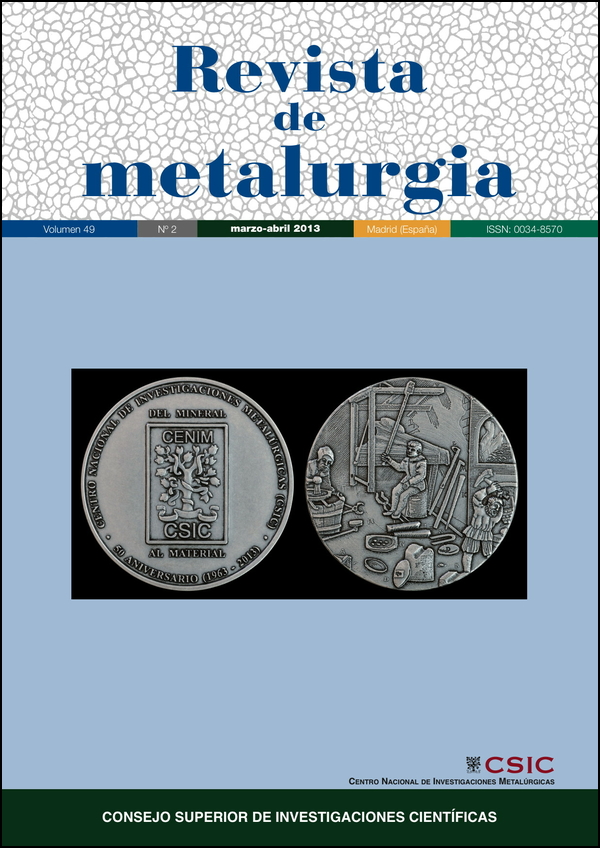The dissolution of chalcopyrite in chloride media
DOI:
https://doi.org/10.3989/revmetalm.1217Keywords:
Dissolution of chalcopyrite, Chloride media, Solution potential, Catalysts additives, MnO2, Pyrite, Silver ionsAbstract
The aim of this investigation is to determinate the effects of parameters and additives on the kinetics of dissolution of chalcopyrite on moderated conditions by means of dissolutions test with chalcopyrite concentrate and pure chalcopyrite in shake flasks and instrumented stirred reactors. A study of the dissolution of chalcopyrite in chloride solutions has demonstrated that the rate of dissolution of chalcopyrite is strongly dependent on the potential of the solution within a range of 540 to 630 mV (versus SHE). Leaching at pH around 2.5 results in increased rates of copper dissolution suggesting the possibility to keep the solution potential within the range. Both pyrite and silver ions enhance the dissolution of chalcopyrite and this effect increases when both species are present. The MnO2 has a negative effect on the dissolution increasing the solution potential to values where the rate decreases considerably.
Downloads
References
[1] A.E. Elsherief,Miner. Eng. 15 (2002) 215-223. http://dx.doi.org/10.1016/S0892-6875(01)00208-4
[2] M.B Stott, H.R Watling, P.D. Franzmann y D. Sutton, Miner. Eng. 13 (2000) 1.117-1.127. http://dx.doi.org/10.1016/S0892-6875(00)00095-9
[3] Z.Y. Lu, M.I. Jeffrey y F. Lawson, Hydrometallurgy 56 (2000) 189-202. http://dx.doi.org/10.1016/S0304-386X(00)00075-X
[4] P.A. Moreno, H. Aral, J. Cuevas, A. Monardes, M. Adaro, T. Norgate y W. Bruckard, Miner. Eng. 24 (2011) 852-858. http://dx.doi.org/10.1016/j.mineng.2011.03.009
[5] L. Velásquez, M. Nicol y H. Miki, Hydrometallurgy 103 (2010) 108-113. http://dx.doi.org/10.1016/j.hydromet.2010.03.001
[6] E.M. Córdoba, J.A. Mu-oz, M.L. Blázquez, F. González y A. Ballester, Hydrometallurgy 93 (2008) 88-96. http://dx.doi.org/10.1016/j.hydromet.2008.04.016
[7] J.E. Dutrizac, Hydrometallurgy 29 (1992) 1-45. http://dx.doi.org/10.1016/0304-386X(92)90004-J
[8] M. AL-Harahsheh, S. Kingman y A. AL-Harahsheh, Hydrometallurgy 91 (2008) 89-97. http://dx.doi.org/10.1016/j.hydromet.2007.11.011
[9] G. Nazari, D.G. Dixon y D.B. Dreisinger, Hydrometallurgy 105 (2011) 251-258. http://dx.doi.org/10.1016/j.hydromet.2010.10.013
[10] L. Velásquez, M. Nicol y H. Miki, Hydrometallurgy 103 (2010) 80-85. http://dx.doi.org/10.1016/j.hydromet.2010.03.004
[11] L. Velásquez, M. Nicol y H. Miki, Hydrometallurgy 103 (2010) 86-95. http://dx.doi.org/10.1016/j.hydromet.2010.03.003
[12] N. Hiroyoshi, M. Arai, H. Miki, M. Tsunekawa y T. Hirajima, Hydrometallurgy 63 (2002) 257- 267. http://dx.doi.org/10.1016/S0304-386X(01)00228-6
Downloads
Published
How to Cite
Issue
Section
License
Copyright (c) 2013 Consejo Superior de Investigaciones Científicas (CSIC)

This work is licensed under a Creative Commons Attribution 4.0 International License.
© CSIC. Manuscripts published in both the printed and online versions of this Journal are the property of Consejo Superior de Investigaciones Científicas, and quoting this source is a requirement for any partial or full reproduction.
All contents of this electronic edition, except where otherwise noted, are distributed under a “Creative Commons Attribution 4.0 International” (CC BY 4.0) License. You may read the basic information and the legal text of the license. The indication of the CC BY 4.0 License must be expressly stated in this way when necessary.
Self-archiving in repositories, personal webpages or similar, of any version other than the published by the Editor, is not allowed.
















